After a week away and a couple of thunderstorms inundating the garden all the weeds are happy and flourishing. So much for the mulch of pine needles which covered the area under the ex-Christmas tree cut down last December. I think the mulch would have worked if we had not had such a high rainfall.
The rainfall has meant that the grass needs cutting more frequently than usual. Everywhere is still green but my husband makes sure to leave patches uncut so we can enjoy watching the bees.
The tall yellow flowers that they love are not dandelions, but catsears (Hypochaeris radicata), I think.
They are the favourite of the solitary bee Dasypoda hirtipes, the Abeille à culottes.
She is not the only bee that favours these weeds but I have not yet found out what this one is called.
The Rudbeckia provides another splash of yellow.
These flowers stand two metres tall. They self-seed onto the patch they have grown on the previous year and I have to thin them out to allow them sufficient space to grow. They are perfect for the summer as they take the sun well and are drought tolerant although they have had lots of rain this year.
My Fuschia is two metres tall, too.
This is another perfect summer plant that gives so much for so little care. I now have a cutting of it in the back garden that is doing well. It is called Riccartonii, and I would love to have another hardy Fuschia with a different colour or flowers but this is the only variety I have seen in this area. Is it the only reliable perennial Fuschia?
My Hydrangea must be enjoying the wetter conditions as it is full of flowers. Hot, dry conditions should be avoided for Hydrangeas but mine seems to thrive against a wall in the sun! Two cuttings are also doing well in a sunny spot in the back garden so I think I must have a particularly rugged specimen.
I am always impressed by the rugged plants that thrive no matter what. The poppies seem to have taken advantage of the rain and have extended their season this year.
I have decided you can’t have too many poppies and I plan to sow even more next year.
All through the year I put aside the seeds of the plants I want to increase the following year. It makes sense to increase the flowers that work in the garden (and for me attract the bees) but I had never thought about the economies that could be achieved gathering seeds. I was amazed that The Garden Impressionists had collected over a £100 worth of yellow rattle seed that they will be able to re-sow in their wild flower meadow next year.
But if you do put your seeds to dry, do remember to label them as a lot of little black seeds can look very similar!

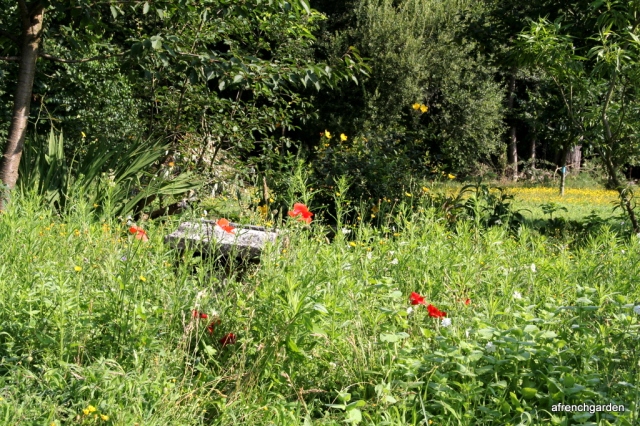



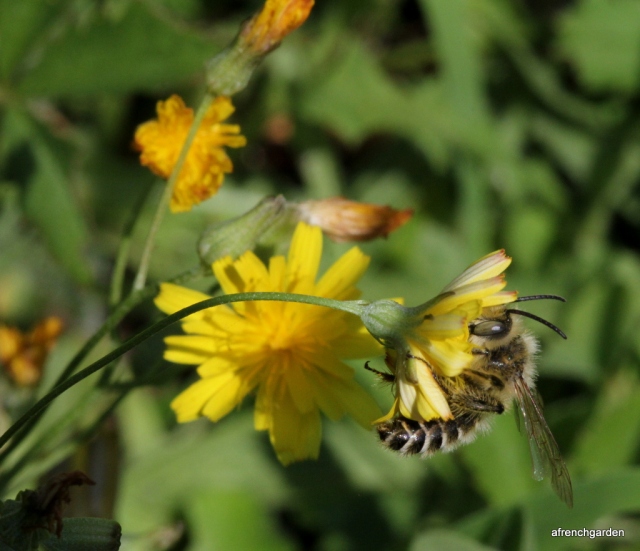

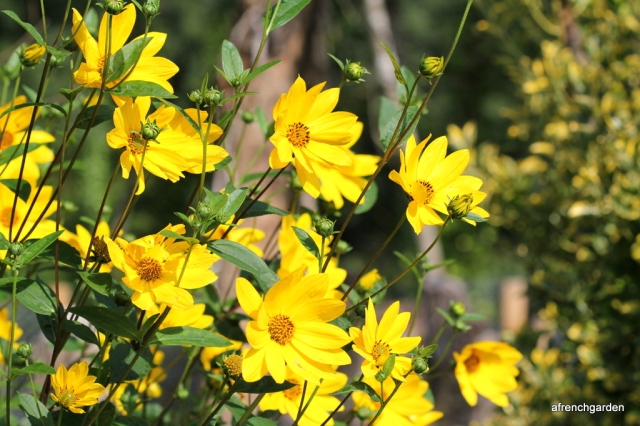

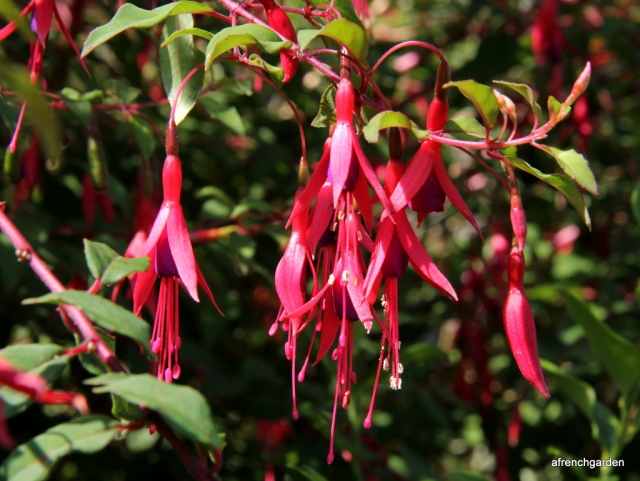

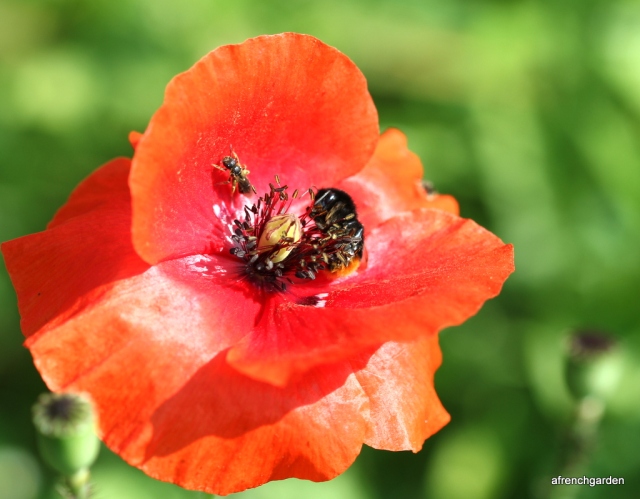
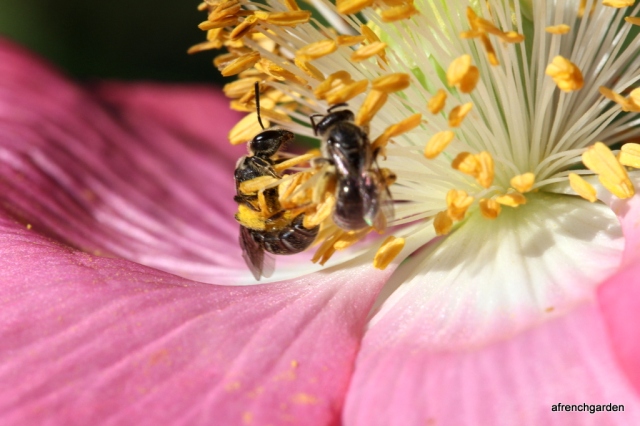
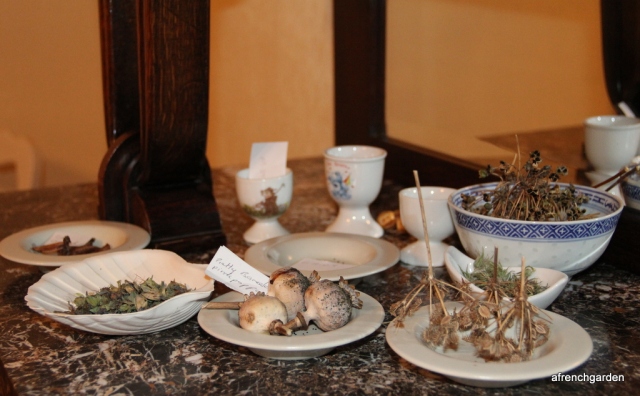
Awesome pollinators! Very nice pictures.
LikeLike
I love my bees and everything I plant is with them in mind. The bees keep me company in the garden all year round as I even get bumble bee queens out looking for nectar on sunny days in the winter. Amelia
LikeLike
That’s really lovely to hear!!
LikeLike
Beautiful photographs Amelia, your garden is looking lovely. You made me smile too, I have a few bags of seeds without labels!
LikeLike
I love guessing games 🙂 Amelia
LikeLike
Yeah, I’m ambivalent about mulch as a weed suppressor. In my experience it doesn’t. But it does make weeds easier to pull up which is never a bad thing.
LikeLike
I’ve been successful with wood chip/bark mulches and I use that under my strawberries. I’ve had fewer weeds, and as you say, the ones that do make it are easier to pull out. Amelia
LikeLike
You could sow any unmarked seeds in a wildflower garden and be surprised! I’ve never grown hardy fuchsia so I’m afraid I can’t be any help there. The gardens are looking great.
LikeLike
I’m pretty good with my marking but pot luck plot is a good idea. Amelia
LikeLike
I think it’s great when people leave a “Patch for Pollinators.” I’m leaving my whole field. Hope my neighbors don’t mind, but I see a lot of dandelions, a little clover, and some Birds Foot Trefoil along with other kinds of unknown wildflowers.
That’s a great stand of Rudbeckias. I didn’t know they grew so tall.
LikeLike
A field for pollinators is great. It will attract such a variety of pollinators. They all seem to have their particular favourites when there is a choice of flowers available. Amelia
LikeLike
Your post made me smile today – I have just arrived home after two weeks away to find my garden had turned into a weed jungle despite all my preparations! I grow two other hardy fuchsias that are very reliable here (south east england). Fuchsia Hawkshead has pure white flowers and fuchsia magellanica var. molinae is a very pretty pale pink.
LikeLike
Thanks for the names of your hardy fuchsia, I prefer a tried and tested recommendation! I have not heard of those so I will make a note for the autumn and see what I can find. Amelia
LikeLike
I don’t think I would dare leave my garden at this time of year after all the rain we have had this spring and summer…. it seems everything grows a few inches overnight – including the weeds! Your garden looks wonderful – the weather has been ideal for your plants too. 🙂
LikeLike
I planted a few things last year that I would have had to be careful with if it had been a dry summer so it has meant less work, so far. Amelia
LikeLike
Hello Amelia,
Thanks for the mention in this post, which has some lovely photos. I really like the Cat’s Ear too, and have been trying to build up numbers by scattering seeds, but your patch looks fabulous, and puts mine to shame.
re Fuchsia’s we grow 2 which are reliable perennials ( with us)…a magellicana alba ( but maybe Julie above has the correct name for it), which is a nice pale pink,(a bit prone to a capsid/aphid which can distort foliage and flowers) and ‘Duchy of Cornwall seedling’, which came from Prince Charles’ nursery in Devon. It’s our favourite, with a bit more blue in the flower than your F. It also has seeded around quite well last winter, attracts bees, and has lovely red stems – we’d grow it for the foliage alone. We do cut them all down in the spring, but they shoot up ever higher as they mature – they’d probably overwinter OK with you.
I couldn’t agree more about needing to label seeds- I’m hopeless at it much to F’s annoyance- but I like your elegant array of seed storage vessels.
Finally it’s interesting to hear about the summer rains in Europe – we’re having one of our driest ever summers here – great for collecting seed, but some plants are really struggling now in the garden, and with spring water only, we have to prioritise what gets any – livestock, plants or a bath for us,
BW
Julian
LikeLike
Thanks for the names of good perennial fuchsia, I am sure anything that would be hardy where you are would be fine here. To think how I used to hate the Catsears in the grass before I noticed the bees! It sounds very strange to be short of rain in Wales, I hadn’t realised how local the rainfall is this year. Amelia
LikeLike
“But if you do put your seeds to dry, do remember to label them as a lot of little black seeds can look very similar!”….
Just mix them up and call it a “wild” flower mix….
we use the paper bags that the boulangeries so thoughtfully supply…
the top with the stalks can be kept clipped shut…
and the bag shaken to release the seed without spillage.
We too have a weed problem…
the combination of sun and rain seems just perfect!!
With the fact that our “autoportee”mower has been out of action….
with a broken mower-drive clutch spring….
means that the Allen scythe will have to be used first…
so I am frantically trying to make a pair of wide skids to avoid damage to the turf in the verger!!
Potager, however, is fine….
I’ve been able to keep that tidy and short with our original tondeuse….
that, normally now, only does the paths between the beds and keeps edges tidy…
must go and mow…
before it gets too hot…
keep on bee’ing.
LikeLike
What a year to have a panne d’autoportee! I cannot see me wielding a scythe, I think I would just wave a white flag and lie down amongst the weeds, coward that I am. Bon courage! Amelia
LikeLike
Amelia….
the Allen scythe is powered!!
Fortunately….
I’m with you on the manual scythe.
Autoportee repaired and has done the rest of the potager area…
but even sitting at 3.5″ it complained in the longer grass of the verger…
off to get milk, paper and a “Euromillions” ticket!!!
Then, having won, I can afford one of those small, very white Lamborghini tractors….
they are narrow enough to fit across the bridge.
Untill then…
it is follow the Allen scythe round the meadow…………….
there are pix, taken by my dear wife….
of me grimmacing as I battle to steer it….
they are on Art’n’Saule
LikeLike
and I had visions of you, scythe in hand, like old man time getting into a swooshing rhythm! 🙂
LikeLike
I saw a gardening programme where the gardener put a ribbon marker on particular blooms (not plants) that she liked and collected the seed from them when they dried.
LikeLike
I have done that for my poppies as it is often difficult to remember which one had the flower you liked. Also my sister points out the ones she likes when she stays with us and I save the seeds for her. Of course, with the poppies they all turn out different anyway but we still do it 🙂 Amelia
LikeLike
Ah well, as long as there are poppies, that’s the main thing.
LikeLike
Interestingly on reading in your blog about the poppies this year, I have noticed, even on urban roadside grassy bits where I live, that there are profusions of poppies this year and they have been there for weeks already. Long may they live.
LikeLike
The sunshine and rain has kept them going this year, a bonus for the bees! Amelia
LikeLike
Here in south Devon we are also suffering from a prolonged dry spell and the gardens show it, it’s supposed to change on Friday.
LikeLike
The rain situation seems to be different in different parts of the UK this year. Amelia
LikeLike
Weeds are just wild flowers and I quite like most of them.
LikeLike
I think the difference between flowers, and this applies to cultivated varieties as well as wild flowers, is whether they are invasive or not. I would love the garden to be over run with wild anemones, pulmonaria and orchids. Unfortunately some of the weeds are very vigorous and can choke out other plants. For this reason there are many cultivated varieties like Vinca that I would never plant. However, when it comes to a plant my bees like…:) Amelia
LikeLike
What beautiful flowers to welcome you home. All those sunny yellows are perfect for this time of year. I’m starting a list of what to grow when I’ve got more sun and am going to add poppies to it for sure. Unfortunately, perennial Fuchsias are an oxymoron around here without a greenhouse.
LikeLike
Fuschia will not support a very cold winter. I prefer choosing plants for the garden that are happy in their growing zone. There is enough work in a garden without having to move plants to greenhouses or cover with fleeces unless you have a very strong attachment for the plant. Poppies give such a lot back for so little care. Amelia
LikeLike
Hi Amelia, I grow Fuchsia magellanica var. molinae at the Priory. There it is usually knocked back to ground level each winter but always comes back. I suppose it would be more robust with you. Dave
LikeLike
Thanks for that. Now I have a few choices to try and source in the autumn. We do get sub zero temperatures here in winter and I always cut down the fuchsia but it seems to work out that if it can survive in the south of England, it can survive here. Amelia
LikeLike
Are those rudbeckia fulgida? I tried to grow some this year but the seed was old and none germinated. According to the packet it’s meant to be perennial. Our Rudbeckia Hirta (sold as annual) are now in their third year and providing loads of colour. We have a variegated hardy fuschia which was a cutting from my dad’s garden in Birmingham, hardy as a polar bear, no idea of the name though.
LikeLike
I’m pretty sure they are Rudbeckia but they were given to me by a neighbour and she doesn’t know what variety they are either. They grow, largely unwatered, on the side of her drive so they are ideal for dry places. These seem to self-seed as well as take readily from transplanted roots. Apart from being pretty they also attract a lot of pollinators so are ideal summer flowers for here. Amelia
LikeLike
Lovely images of your bees and your garden Amelia. Hydrangeas look terrible if they are in the sun here, you are far enough north that they are obviously very happy. Well done for saving so many seeds. Do you direct sow or just sprinkle where you want them to grow?
LikeLike
It depends on what they are but usually I go the seed tray route unless for a few like poppies or larkspur. Amelia
LikeLike